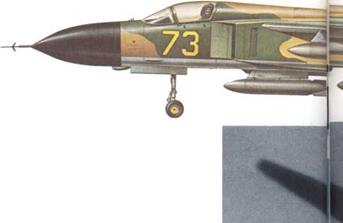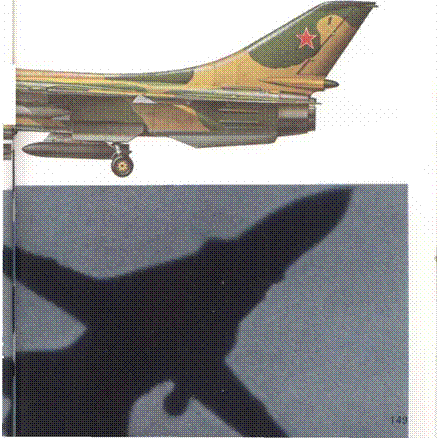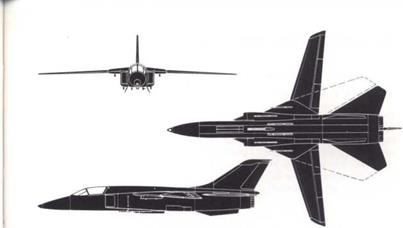Sukhoi Su-19
Su-19 versions known to NATO as "Fencer"
Origin: The design bureau of Pavel 0. Sukhoi. Soviet Union.
Type: Two-seat multi-role combat aircraft.
Engines: Two afterburning turbofan or turbojet engines, probably two 24,500lb (11.113kg) Lyulka AL-21F3.
Dimensions: (Estimated) span (spread, about 22°) 56ft 3in (17-5m), swept (about 72°) 31ft 3in (9-53m); length 69ft 10in (21 -29m); height 21ft (6-4m).
Weights: (Estimated) empty 35,000lb (15,875kg): maximum loaded 70.000lb (31.750kg).
Performance: (Estimated) maximum speed, clean, 950mph (1 530km/h, Mach 1-25) at sea level, about 1,650mph (2655km/h, Mach 2-5) at altitude: initial climb, over 40,000ft (12,200m)/min: service ceiling, about 60,000ft (18,290m), combat radius with maximum weapons, about 500 miles (805km): ferry range, over 2,500 miles (4025km).
Armament: One 23mm GSh-23 twin-barrel cannon in lower centreline: at least six pylons on fuselage, fixed and swinging wings, for wide range of stores including guided and unguided air-to-ground or air-to-air missiles. History: First flight, probably about 1970: service delivery. 1974 or earlier. User: Soviet Union (mainly FA).
Development: First identified publicly in the West by the Chairman of the US Joint Chiefs of Staff, who described the Su-19 as “the first modern Soviet fighter to be developed specifically as a fighter-bomber for the ground-attack mission", this aircraft will probably be the chief tactical attack aircraft of the Soviet V-VS in 1980. Like the rival but much smaller MiG-27, the Su-19 is an extremely clean machine strongly reminiscent of the F-111 and Mirage G, having side-by-side seats and wing and tailplane
 Above: This drawing is believed to be as true to life as any yet published – and certainly much better than most, which among other things fail to show a nose large enough to contain the powerful radar. It is worth noting that in 1980, six years after this type entered service and at least 10 years after prototype completion, not one had been seen outside the Soviet Union or even clearly photographed (see below).
Above: This drawing is believed to be as true to life as any yet published – and certainly much better than most, which among other things fail to show a nose large enough to contain the powerful radar. It is worth noting that in 1980, six years after this type entered service and at least 10 years after prototype completion, not one had been seen outside the Soviet Union or even clearly photographed (see below).
Right: In 1980 this blurred shape was still the only authentic illustration of the Su-19 available. It emphasizes the aspect ratio (slenderness in plan shape) of the extremely efficient swingwings, the size of the sensor-studded nose and the large area of the fixed wing gloves, and the main gears which probably have twin wheels.
|
|
|
Three-view of Su-19, showing range of sweep (provisional). |

at the same level, as in the US machine, yet following the French aircraft in general layout. In general capability the nearest Western equivalent is the F-14 Tomcat, which shows just how formidable this aircraft is. Whereas "Foxbat" was on many Western lips in the 1960s, so is "Fencer" a big scare-word in the 1970s. Features of the first service version include a typical Sukhoi tail, but with ventral fins; double-shock side inlets; full-span slats and double-slotted flaps; and very extensive avionics (thought to include a multi-mode attack radar, doppler. laser ranger and very comprehensive EW/ECM installations).











